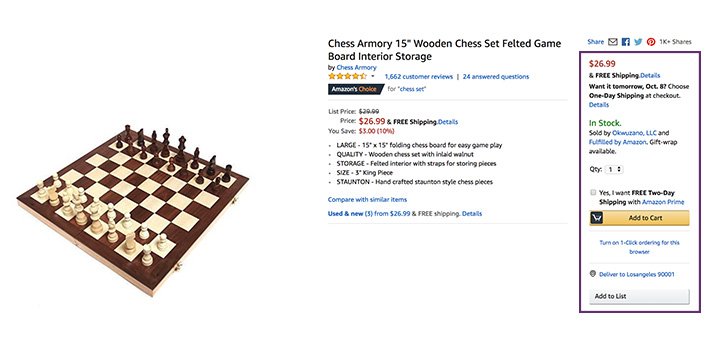
Amazon has trained its customers to look for the best deals and price-check products before they buy. A February 2018 report by Epsilon found that 64% of people cited price as their primary motivation for shopping on Amazon.
However, it’s not always the lowest price that wins on Amazon. While several factors impact which seller a customer will ultimately purchase from, the most influential by far is the Amazon Buy Box.
What is the Buy Box?
Most Amazon sellers are intimately acquainted with the Buy Box, as this section drives as much as 90% of all Amazon sales.
But guess what? There wasn’t always a Buy Box. Amazon first introduced the Buy Box with 1-Click ordering in 1999. This technology gave Amazon an early advantage by prompting customers to buy more and allowing the company to collect their data. At the time, this revolutionary move eliminated the need to scroll through a list of buying options, streamlined the purchase process, and pioneered the Buy Box as we know it today.
The current Amazon Buy Box is the white box on the right side of a product detail page, where customers can add an item to their cart or make an instant purchase. When one of your listed items appears as the default on the product page, you “win” the Buy Box, increasing your chances of selling that item. However, a single product is usually offered by multiple sellers, and Amazon’s customer-centric approach means only sellers with excellent metrics are eligible to compete for this valuable real estate.

So how does a seller “win” the Buy Box? Amazon looks at several factors when determining Buy Box eligibility including a seller’s status, and a product’s fulfillment method, performance data, inventory, and price.
1. Selling Status
The very first requirement for Buy Box eligibility is an Amazon Professional Selling account. Individual Sellers are not eligible. A Professional Selling plan has a monthly subscription fee rather than a fee for each item sold.
Private Label sellers (those selling products on Amazon under their retail brand instead of a manufacturer) will usually win the Buy Box as they are the only seller of their product.
If you're selling as a wholesaler or via retail arbitrage, it can take several months before you win the Buy Box. Amazon uses this time to monitor your sales performance and ensure that you meet their requirements and customer satisfaction standards.
It’s also important to note that not all products and product categories are eligible for the Buy Box. You can check your product’s eligibility via the Preferences button on your Manage Inventory page. Selecting “Buy Box Eligible” will display the status for each of your ASINs.
2. Fulfillment Method
While it isn’t impossible to grab the Buy Box by fulfilling orders yourself, it’s challenging. If your product is at a warehouse in California and someone is purchasing your product on the East Coast, it’s unlikely that your product will show up in the Buy Box, even if your product is less expensive.
Amazon wants to ensure that it can ship a product to a customer within the promised two-day Prime window. That means that customers are shown the products that are closest to them first.
Using Fulfillment by Amazon (FBA) can greatly improve your chances of being selected for the Buy Box. This gives Amazon peace of mind as they know the quality of the packaging and can control how quickly it reaches customers.
If you choose to fulfill orders yourself, you must display evidence (through performance, reviews, and sales over time) that you can meet Amazon’s high standards for shipping and customer service in order to win the Buy Box.
Pro Tip: A seller with a slightly higher price that is fulfilling through Amazon has a better chance of winning the buy box than a seller fulfilling orders themselves at a lower price point.
3. Performance Data
Amazon has a variety of performance targets to gauge each seller’s reliability. The better your performance metrics, the better your chances of winning the Buy Box.
You can view these metrics under the Performance tab in Seller Central. Pay particularly close attention to your Order Defect Rate, Return Dissatisfaction Rate, Contact Response Time, and your Valid Tracking Rate.
Order Defect Rate (ODR)
Your ODR is calculated by taking the number of orders with a defect and dividing it by your total number of orders. Your goal as an Amazon seller is to keep this rate under 1%. Amazon looks at three different places for “defects”:
A-to-Z Claims: These are any claims that state that your product arrived late or in less-than-pristine condition. To avoid these claims, make sure you accurately represent your product in your listing. You can also keep your A-to-Z claims low by providing quality packaging to prevent any damage during shipping.
Negative Seller Feedback: Any feedback directly related to you as a seller rather than your product is included here. Providing excellent customer service and solving customer complaints can help this metric. Note that Amazon has recently made changes to their policy on removing seller feedback.
Service Chargebacks: Chargebacks occur when your customer disputes a charge with their bank because an item is damaged or faulty. Once again, invest in quality packaging to avoid this outcome.
Customer Service
Several different metrics measure the quality of your customer interactions. These two are very important when determining your Buy Box eligibility:
Return Dissatisfaction Rate: Amazon calculates this metric by the percentage of returns that result in negative feedback, late responses to returns, and returns that are incorrectly rejected. Quick and accurate responses can keep this metric below the 10% mark.
Contact Response Time (CRT): Contact Response Time is calculated as an average of the number of customer messages that you’ve responded to within 24 hours of receipt. You should check these messages daily at a minimum.
Shipping Performance
Valid Tracking Rate (VTR): This is a metric for FBM sellers. Amazon customers depend on tracking numbers to find out where their orders are and when they can expect to receive them. Valid Tracking Rate is calculated by taking all shipments with a valid tracking number and dividing it by your total shipments over a thirty-day period. Amazon policy dictates that you must keep this metric above 95%. If you fail to do so Amazon can restrict your ability to fulfill orders yourself.
Amazon places the highest importance on maintaining the trust and satisfaction of their millions of buyers. To win the Buy Box sellers must meet or exceed performance targets for every product they sell.
4. Inventory
One thing that will disqualify you from the Buy Box is low or inconsistent stock. If you have a lower price but another seller has significantly more product available, they’ll likely be chosen over you because Amazon is more confident that they’ll be able to fulfill the order.
To avoid this problem make sure to replenish your inventory on a regular basis, especially for your best-sellers.
Remember, Amazon can only see what's in their warehouses, not yours. Make sure to maintain a consistent level of product and account for the time it takes for Amazon to receive new inventory.
5. Price
To win a spot in the Buy Box you have to keep your prices competitive. While having the lowest price does result in sales, over time customers may begin to associate your product with low quality. To avoid this, always set your price 2% higher than the lowest price already on the market. On the higher end, to remain on the first page of search results your price should not be more than 20% higher than the competition.
Don’t panic if a seller appears to be selling the same product at an incredibly low rate. With such a low price they’ll likely run through their stock quickly and you’ll have another opportunity to capture the Buy Box. The key is to be patient and know your margins.
Can Dynamic Pricing Help Your Sales?
Amazon’s dynamic pricing – the ability to quickly change a product’s price – is part of Amazon’s appeal for both customers and sellers. Allowing multiple merchants to sell the same product creates a competitive environment where prices are fluid. If an item is in high demand or short supply, the price is likely to rise. When an item is overstocked or unpopular, sellers can lower their prices to compete for sales.
Amazon itself contributes to this phenomenon (with its private label products) more than anyone else! Their access to shopper behavior and an elaborate algorithm allows them to shift prices at an unprecedented rate. They change prices an astounding 2.5 million times a day!
On average, a product on Amazon gets a price change every ten minutes. It’s unlikely you’ll be able to make that many price changes; however, you should monitor and adjust your prices often. It’s an advantage of selling on Amazon that many sellers don’t utilize.
One way to gauge the demand for a product is through keyword search volume. Monitor the search volumes for your keywords to help determine if you should increase or decrease your pricing.
Remember to keep an eye on other sellers’ pricing and metrics as well! By maintaining high performance and paying attention to your competitor’s seller ratings, feedback, and shipping options you may uncover opportunities to offer your product at a higher price point.
Where’s the Amazon Buy Box going next?
Buying Used
Recently, Amazon added a Buy Used option to the Buy Box. While this feature has been available on items like books and DVDs for some time, it is now available across all Amazon categories.
Sellers listing used products are still subject to the same rigorous standards as sellers with new products.
Adding this option to the Buy Box provides an opportunity for new sellers to join the marketplace and existing sellers to sell gently used items.
Changing the Game
Amazon upended the purchase process with the introduction of the Buy Box. It’s no longer enough to have a low price or excellent search ranking to earn sales. Competing for the coveted “Add to Cart" location requires sellers to maintain the highest levels of quality and satisfaction.
While there's no proven formula to “win” the Amazon Buy Box, you can keep your seller metrics high and identify opportunities that increase your odds. Study who’s currently winning the Buy Box, the number of competitors you have, their pricing and shipping history, and your own pricing over time. Collectively, these data points can help you build a winning strategy.
With mobile apps and voice purchasing, the ways customers shop and buy products are already changing. It’s entirely possible for Amazon to transform the purchasing process again. Pay attention to consumer trends and the latest Buy Box eligibility requirements to see how this process evolves.


